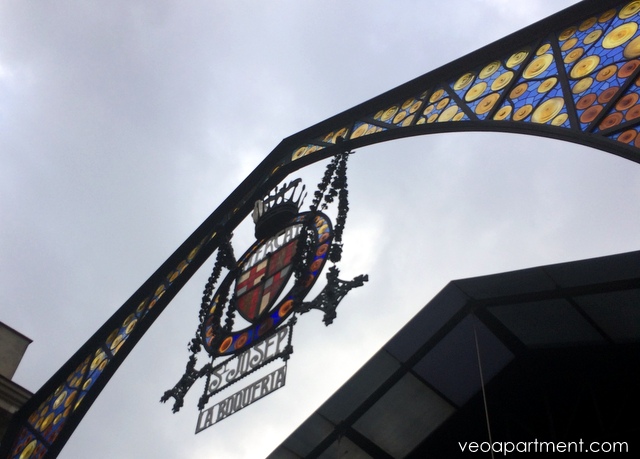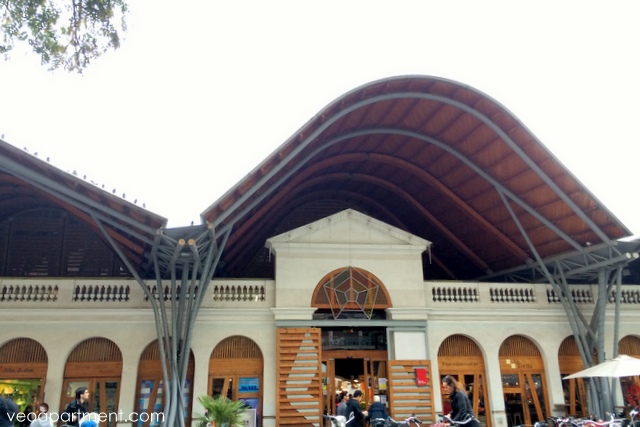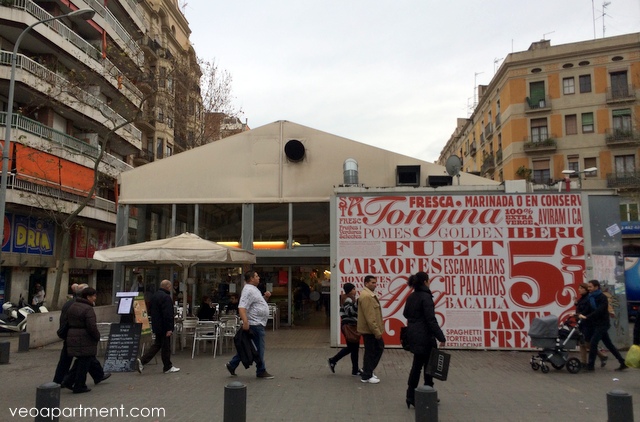Whether you’re something of a “foodie”, or just a regular visitor seeing the sights, no visit to a Spanish city is complete without visiting at least one of its markets. Apart from its obvious practicality if you’re self-catering in an apartment (better than a hotel if you’re a group or family and staying more than a couple of nights), it’s one of the best ways of experiencing the day to day life and culture of the locals – what they buy and how they shop, and usually with an opportunity to sample some of it at a market cafe or bar. If it’s a bit overwhelming you could try one of the many market food tours such as The Barcelona Taste or Aborigens to get your bearings, or enjoy shopping and then cooking your purchases with an Eat With verified local host.
As you might expect, a city the size of Barcelona has quite a number of such markets, though the ones that the typical visitor is most likely to see are the three markets in and around the Ciutat Vella, the old city.
 the entrance to La Boquería market
the entrance to La Boquería market
La Boqueria
The most well-known of these is certainly Sant Josep de la Boqueria, located on the infamous Las Ramblas in the heart of the tourist neighbourhood between the Barri Gotic and El Raval. There’s been a market hereabouts since at least 1217, though the current building was constructed between 1840 and 1853, and although it’s still very much a working market it has now become a major attraction in its own right. There’s an impressive entrance, complete with a coat of arms surmounted by a bat*, but it’s set just a little way back from the street, so it’s surprisingly easy to miss if you’re not looking for it. The space inside seems huge, a cathedral of food, and with almost 300 stalls there’s plenty to choose from.
 Santa Caterina is even more impressive when seen from above
Santa Caterina is even more impressive when seen from above
Santa Caterina
Santa Caterina market, just off the Via Laietana in the La Ribera neighbourhood was the first of Barcelona’s covered markets to be renovated (in 2005), and is now most notable for its modernist undulating coloured roof, which you can get a good view of from the top of the nearby cathedral, and all that fabulous local fresh food of course. Less crowded than the Boqueria, with more space and light around the stalls and fewer bars, it nevertheless has a definite charm of its own, and it’s well worth taking the time to come here.
 temporary installation for Sant Antoni Market
temporary installation for Sant Antoni Market
Sant Antoni
Sant Antoni is technically in the Eixample district, but really it’s right on the boundary with the old El Raval neighbourhood, where it was built in the 1880s to serve the new neighbourhoods of the growing city. Since 2009 it has been housed in rather shabby temporary accommodation on the Ronda Sant-Antoni while the original building is being renovated. Work should be completed, and the market restored to its proper home, in 2016, together with the famous Sunday collectors’ and books market. The original ground plan in the shape of a Greek cross, surrounded by a circular covered gallery where the non-food stalls are housed, will be preserved, and the new building will also incorporate the medieval remains discovered during the works.
Other markets worth a visit include La Barceloneta, with it’s unusual roof, La Concepció in the Eixample which has a classic cast-iron and glass frontage, and Sant Marti in the eastern part of the city.
* The Bat is a heraldic symbol of the former crown of Aragon, and is thought to have originally represented a dragon. Officially it is no longer part of the coat of arms of Barcelona, but still appears on older versions and on some street furniture such as street lamps.